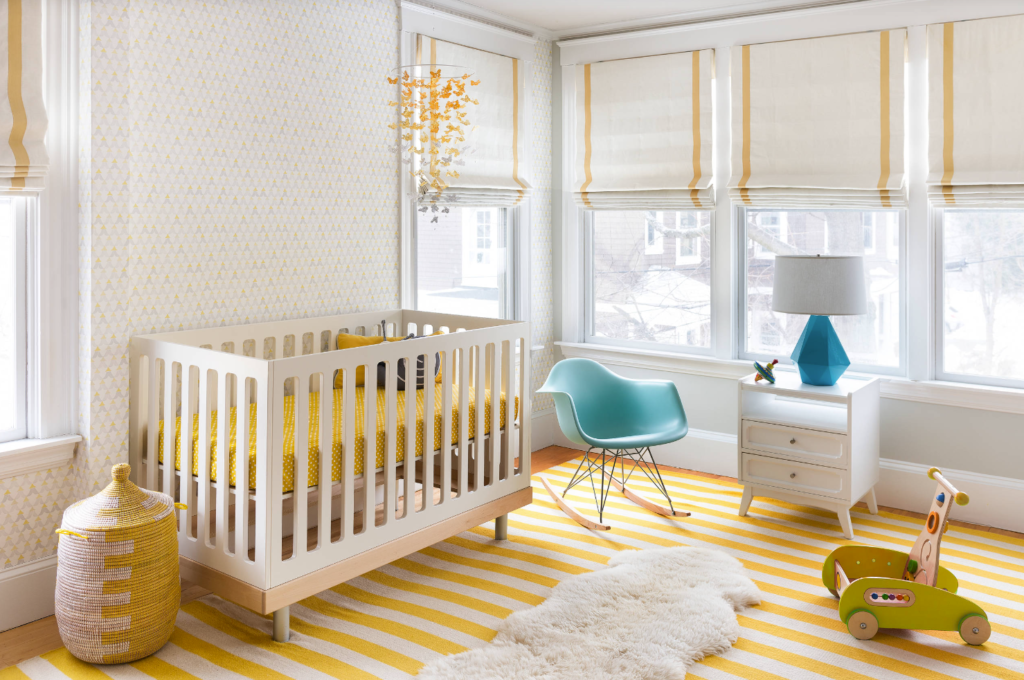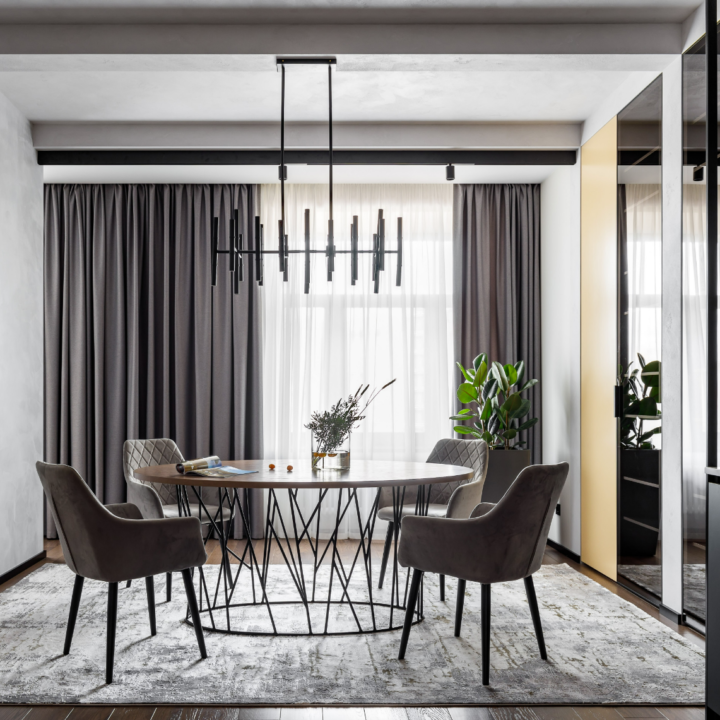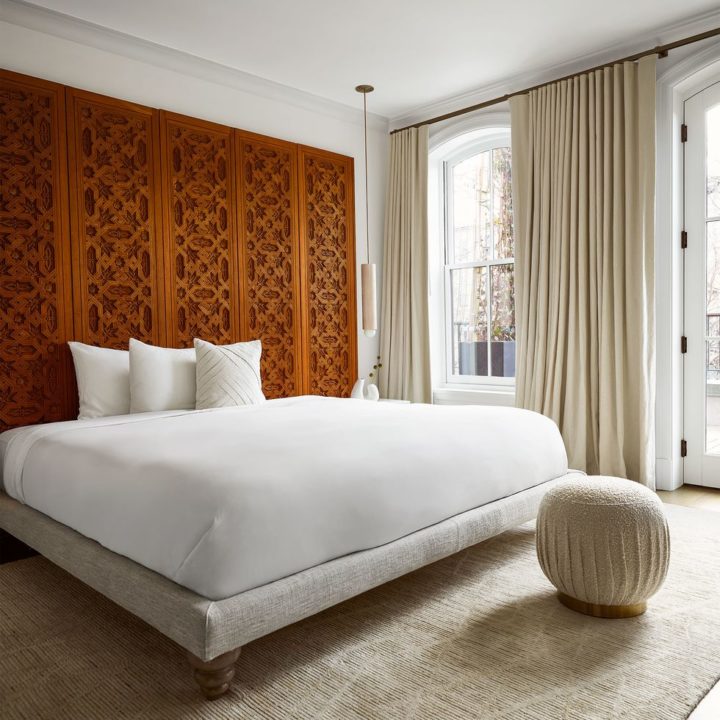Spiffy Speak
KID COUTURE: THE BEST ROMAN SHADES FOR NURSERY

One of the most enjoyable moments for a new parent is decorating the nursery of a newborn. Your inner child unabashedly indulges in color and whimsy to create a space as charming as a dream. And when your baby blissfully sails to the ‘world of dreams’ on a sleepy ferry without a fuss – that’s when you know you have truly nailed it!
The transition from a fairytale page to a dark cocoon must be smooth, instant and effortless, and the right window treatments go a long way in making it possible. With this goal, if you’re out shopping for roman shades for your baby’s nursery, find yourself in safe hands as you travel through our stylists’ tips, and get a sneak peek into our catalog for inspiration.
Shop for custom roman shades for nursery from Spiffy Spools. Like your baby’s own fairy godmother with a wand in hand, we can style your nursery as you desire- from pretty blackouts to dreamy sheers and cartoon prints to checkered flair, our vast collection of over 3000 fabrics has got it all for you!
Reasons to Love Roman Shades for Nursery Windows
When the expectations are soaring high, designers put the best players on the frontline. If asked what’s the best nursery window dressing, we’d say it in a heartbeat – roman shades. And here’s why –
- SAFETY FIRST, LAST, AND ALWAYS: With roman shades, you need not worry about your baby getting entangled in long flowing trails of fabric because roman shades stop at the sill. The pull cords can easily be secured with anchors to keep the dangling cords inaccessible to the kid, ensuring complete safety. Parents can also consider cordless roman shades to avoid cords completely. Furthermore, they also have the option to choose hypoallergenic, natural fabrics like cottons and linens for their nursery roman shades, avoiding man-made, chemically treated materials.
- NEAR-PERFECT LIGHT BLOCKAGE: With a continuous single-panel structure backed by a blackout lining, roman shades are capable of blocking a high degree of incoming light.
- HIGHLY CUSTOMIZABLE: Unlike industrially produced roller shades and slatted blinds, roman shades allow you to choose the palette, pattern and texture of your liking – making them the favorites of imaginative designers as well as doting parents.
- HIGH-END APPEAL: Roman shades add to your nursery decor a handmade goodie and a personalized high-quality curated product in an exquisite fabric. It’s an elevated look that no factory-made shade or blind can offer.
- VERSATILITY: Where curtains might be too traditional and industrial blinds too modern, roman shades vouch affinity to both tastes. Depending on the fabric chosen, you can bring the complex decorativeness of the yesteryears or the clean lines of contemporary times to any desired degree into your nursery.
Elegantly Efficient: Nursery Roman Shades at Their Best
Since you’ve found out why roman shades are the perfect mix of style and function for nurseries, you’re probably as impressed as we are. The most beautiful part of the deal is that you can design every single part of the shade to suit your specific liking, decor style and needs. So, let’s introduce you to the tips and tricks that will make this journey of styling and decorating a cakewalk for you –
Daylight, Dimlit or Deep-Dark: Have the Control At Your Fingertips
A nursery is a place for magic and fantasy, but the hardest feat to be performed here is the instantaneous transition from a bright sprightly hub to a dark soothing cave. And that has to happen at your hands, at your will. The fabric choice for your roman shades will have a lot to do with making this act effortless, and that’s why, decide on the fabric base before anything else.
BLACKOUT SHADES AS STAND-ALONE
For roman shades that are intended for use as stand-alone treatments, you need blackout or dimout fabrics, backed again by a blackout lining for maximum darkness even during afternoon nap times.
Blackout fabrics block incoming light fully whereas dimout fabrics achieve this goal substantially, not totally. They also keep away noise and external heat from entering the nursery and maintain its temperature. For a better understanding of room-darkening fabrics and tips to use blackout lining, do read our extensive blog on this topic.
And have a peek into our blackout and dimout roman shades collection. Our Cap Ferret blackout roman shades are wisely crafted in grey-yellow chevrons for a timeless and gender-neutral addition to any nursery. And dimout Orchid Bay roman shades make their classy damasks look solemn yet fanciful in a gentle gray-pink palette.
ROMAN SHADES AS SECOND LAYER
On the other hand, for roman shades that will be layered on with blackout curtains for nursery or a second set of blinds, you can consider light-filtering fabrics such as sheers, semi-sheers or loosely woven linen. Light-filtering fabrics ensure privacy and protection from harsh sunlight without making the nursery dark. Blue Penny roman shades from our collection are a lovely example of semi-sheer cotton roman blinds that sport artful embroidered floral motifs in stunning blue and beige tints.
So make the choice of your fabric keeping in mind its light blocking properties, your overall plans for window treatments, local overall climate, window position and size of your nursery windows in relation to the exact type of light control you wish to have.
Inside Vs Outside Mounting: Position the Shade Correctly
The light control aspect of roman shades is not just dependent on the fabric from which it is created but also on how it is mounted. The shade can be made in a perfect-fit size to sit snug within the frame recess close to the pane – known as inside-mounting the shade. Or, it can be installed on the wall outside, sealing the whole window – known as the outside-mounting position. Both positions have their own plus and minus points which we discuss at length in our blog post here.
The decision to mount the shade inside or outside the window will largely depend on the depth of the window frame besides your personal taste and light control requirements of the nursery. Key details follow below:
INSIDE-MOUNTING POSITION
This is the most popular way of mounting sill-length window treatments. Sitting taut within the window frame, this shade commands no wall space and is non-accessible for the baby, making it the most minimalistic and safe window treatment for a nursery. These are the key things to keep in mind:
- The window must be at least 2 inches deep so our shades can be mounted within it comfortably. Furthermore, no handles or other obstructions should come in their way.
- The shade must make seamless contact with the window frame, leaving no gaps for light leaks in between. This requires precision in measurement and the result is a window treatment that relays the custom look at first sight.
- Remember that with this style, the shade’s stacking room is accommodated within the window. Hence, it is better to avoid this mounting position for small windows. An outside-mounted shade might be a better option for small windows as the shade can be positioned to stack on the wall above instead of covering any window space, thereby maximizing light and air when the shade is folded up.
OUTSIDE-MOUNTING POSITION
In this position, the shade is mounted on the wall outside the window frame overlapping the window on all sides, and thereby providing better coverage. You also reserve the possibility to mount another shade/blind within the recess by mounting the roman shade outside.
Keep the following things in mind to outside-mount the shade:
- The headrail should ideally be mounted a few inches above the window trim. If it’s a small window, make sure that the folded stacks are accommodated above the trim so that the shade does not obstruct light, air or the views when it is folded up. It also helps to make the window look larger than it is.
- Extend the shade 4-6 inches in every direction beyond the window trim. This will help minimize light leaks from edges, making for a darker, sleep-friendly room when so desired.
Flat Fold Vs Scalloped: Choose the Apt Style
The next important decision regarding roman shades is regarding their fold style and structure which is directly responsible for their functional aspects. Our roman shades come in three popular styles that may be classified into two broad groups: flat-fold shades and scalloped shades.
Determine the style based on whether your roman shade is a stand-alone or a primary treatment. In a nursery, a standalone shade can be expected to be used several times during the day for naptime, so make sure your choice prioritizes your practical needs. Flat-folds are better for stand-alone shades and scalloped shades are better kept stationary under other functional over-treatments that can be operated easily.
Stitching Stories & Mixing Hues: Palette-Pattern Palooza
The most enjoyable part of planning your nursery’s roman shade is coming ahead. So use the tips below and let the creative in you take over!
PALETTE
Let your decor style, overall room palette and the amount of optical real estate your windows occupy have the primary say on the palette of your roman shades. The following tips may help along the way:
- While babies love saturated colors, too many exciting elements in the ambiance can make it difficult to catch sleep. Soft pastels, on the contrary, are cheery yet soothing to the eye, never making the little one too alert to fall asleep. So, for a small window, opt for saturated colors if you wish, but for a large window, a soothing tone may prove better as it occupies more visual space.
- If cave-like darkness is your goal, once shades are drawn, darker colors of the spectrum will be better friends than lighter ones, even on a blackout fabric.
- If you foresee changing the room’s palette in a couple of years as the nursery’s inhabitant grows, opt for a neutral palette for your roman shades so they can work with the renewed palette.
- We recommend picking the roman shade fabric first before the paint color for the walls so you can find the perfect complementary or contrasting shade. Remember it’s much easier to find a paint color that perfectly matches your textile elements than vice versa.
PATTERN
An easy way to bring lightheartedness to the nursery is to include patterns in the decor. However, your pattern choices must be based on your future plans regarding the nursery and your overall decor style.
- WISE CHOICE OF MOTIFS: While one may be tempted to choose thematic patterns like superheroes or popular cartoon characters, designers are quick to advise against over-investment in such themes, unless the plan is to refresh every couple of years with fickle obsessions of your tot. Otherwise, it might be wiser to choose a fabric featuring classic patterns like polka dots, stripes, florals, etc. that are playful, while also being relatively age-proof. If, however, your heart is set on introducing a cute-sy, theme-based pattern, at minimum, consider keeping the motifs broad in themes so they are somewhat adaptable to changing preferences. For example, a fabric like Princess Pink will sync with many fairytale settings – from Cinderella and Snow White to Frozen and Sleeping Beauty. Similarly, our Peter Pan roman shades have proven to set an adorable cityscape for many nurseries, easily adapting to changing preferences from Superman and Spidey on to a superhero-free decor altogether.
- CHOOSING CORRECT SCALE: Let the size of the window inform the choice of scale. On a small window, tiny and medium scaled patterns match proportions. Whereas, on a large window, you have a choice to go large scale if you wish to make it a focal point of the nursery.
- FACTOR IN DECOR STYLE: Also, make sure that you voice your decor style aptly. A traditional nursery’s wow factor is ornate paisley or damask, a country-styled nursery flaunts its easygoing aesthetics with farmhouse-style roman shades, and a modern nursery wins applause with clean-lined patterns such as this black-and-white chevron print in Baki roman shades.
Conclude with Charm: Add Tasteful Trimmings
If your creativity has not been satiated yet, here is your opportunity to do so by selecting trimmings for your roman shades. These thoughtful additions relay the custom look and color-coordinated design of the nursery effortlessly. Hence, don’t miss the possibility to add tone, pattern or handicraft that can elevate the nursery instantly.
There are a variety of trimmings to choose from in various colors, weaves and finishes. Whatever your vision, be it textured velvet ribbon trims or shiny gimp braids or lush fringe trims, you cannot but find one that suits your taste from our vast catalog of roman shade trims.
Apart from the playfulness and pop of color that they introduce to your nursery window, trims can be used with forethought to advance your design decisions.
Perhaps, you could not find a fabric that relays your palette perfectly – solve the problem by finding a plain fabric that matches your primary tone and a trim that corresponds with the secondary hue. Or, you need to echo the golden details of your vintage accessories in the nursery and a gleaming silken tassel trim on your roman shade could offer the perfect company. Or, perhaps you simply want to convey the lightheartedness of your tot’s personality? Easily done with our plush and adorable pompom trims.
Whatever your goal, you can’t go wrong with these delightful add-ons to bring a truly bespoke look to your nursery roman shades.
READ MORE: TOP ROMAN SHADES IDEAS FOR YOUR HOME
On to the Best Part
We’re at the end of the planning and the beginning of the action. Now, with all the input from this blog, take on the stage and put up the show. Your nursery windows are waiting for the best dressing of their lifetime. Explore our curated collections and start filling your cart. Happy shopping with Spiffy Spools for your favorite custom nursery roman shades!
READ MORE: TOP TIPS & IDEAS FOR NURSERY CURTAINS















